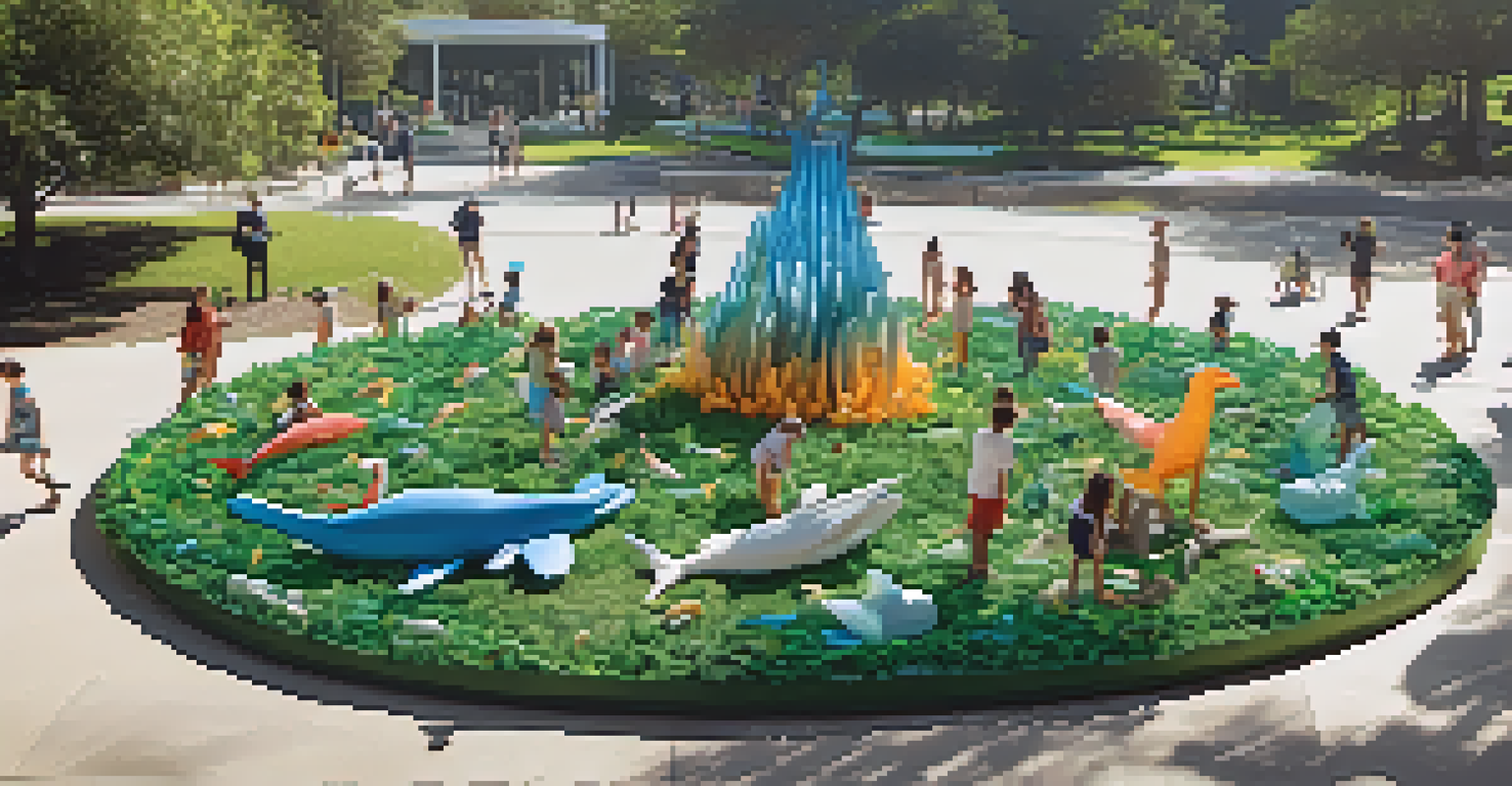Carving Messages: Art that Inspires Environmental Action

The Power of Art in Environmental Awareness
Art has a unique ability to resonate with people, evoking emotions that transcend language barriers. When it comes to environmental issues, art can communicate complex themes in an accessible way, sparking curiosity and prompting action. For example, murals depicting endangered species can raise awareness about biodiversity loss, making the issue personal and relatable.
Art is not a mirror held up to reality, but a hammer with which to shape it.
Consider the impact of a large-scale installation made from recycled materials. Such pieces not only draw attention but also serve as a powerful reminder of what can be achieved through repurposing waste. By engaging viewers visually, artists can inspire them to reflect on their own consumption habits and environmental footprint.
Ultimately, art becomes a vehicle for storytelling, allowing individuals to connect with nature and consider their role in its preservation. This connection is vital for fostering a sense of responsibility toward the environment, encouraging communities to rally around shared values and collective action.
Carving Techniques: Merging Craft with Conservation
Carving, whether in wood, stone, or ice, is an ancient art form that can also carry significant environmental messages. Artists often use reclaimed materials to create unique sculptures that not only showcase their skills but also highlight the importance of sustainability. By choosing to carve from recycled sources, they implicitly advocate for a circular economy, where waste is minimized and resources are reused.

For instance, a sculptor might create a stunning piece from driftwood, transforming discarded materials into a work of art that tells a story of resilience. This not only captivates viewers but also encourages them to see the beauty in what is often overlooked. The tactile nature of carved art invites interaction, prompting a deeper appreciation for the materials used.
Art Sparks Environmental Action
Art has the power to communicate complex environmental issues in relatable ways, inspiring curiosity and prompting community action.
Moreover, the process of carving can serve as a meditative practice for artists, allowing them to reflect on nature and their connection to it. This introspective journey can fuel their passion for environmental conservation, leading to art that not only pleases the eye but also stirs the soul.
Environmental Themes in Carving Art
Carving art often explores themes of nature, sustainability, and climate change, making powerful statements about the state of our planet. Artists draw inspiration from natural landscapes, wildlife, and ecological challenges, using their work to advocate for change. For example, a carved representation of melting glaciers can serve as a stark reminder of climate change's impact on our world.
The artist's job is to be a witness to the world, to capture the beauty and the struggles and to inspire change.
Incorporating environmental messages into their pieces, artists can challenge viewers to reconsider their relationship with the environment. The visual impact of such works can create lasting impressions, encouraging conversations about conservation and sustainability. This dialogue is crucial in mobilizing communities toward action, fostering a collective sense of urgency.
By addressing these themes through carving, artists not only raise awareness but also empower individuals to take ownership of their environmental responsibilities. Each carved piece becomes a testament to the importance of nature, reminding us that we are not separate from it, but rather integral to its future.
Collaborations: Artists and Eco-Organizations Unite
Collaboration between artists and environmental organizations can amplify the impact of carving art. By joining forces, they create projects that blend creativity with advocacy, reaching wider audiences and driving home crucial messages. Such partnerships can result in community art installations that educate the public while beautifying public spaces.
For example, an artist might team up with a local conservation group to carve a series of sculptures highlighting native species. This not only raises awareness about local wildlife but also encourages community involvement in conservation efforts. The process of collective creation fosters a sense of ownership and pride among participants, motivating them to take further action.
Sustainable Carving Techniques
Artists use reclaimed materials in carving to promote sustainability and advocate for a circular economy through their unique sculptures.
These collaborations often lead to events that engage the public, such as workshops or community carving days. By involving people of all ages, they can cultivate a growing appreciation for the arts and the environment, ultimately inspiring a new generation of eco-conscious individuals.
Showcasing Carving Art: Exhibitions and Installations
Exhibitions are vital for showcasing carving art that emphasizes environmental action. By providing a platform for artists to display their work, galleries and museums can educate the public about pressing environmental issues. Interactive installations invite visitors to engage with the art, deepening their understanding of the messages being conveyed.
For instance, an exhibition featuring carved pieces made from ocean plastics can highlight the growing problem of marine pollution. Such displays not only raise awareness but also encourage discussions around solutions and personal responsibility. The visual impact of these artworks can leave a lasting impression, prompting visitors to rethink their own habits.
Additionally, virtual exhibitions have emerged as a powerful way to reach global audiences. Artists can share their work online, connecting with individuals who might not otherwise have access to such art. This democratization of art allows environmental messages to be heard far and wide, inspiring action on a broader scale.
The Role of Social Media in Promoting Carving Art
In today's digital age, social media plays a crucial role in sharing carving art and its environmental messages. Platforms like Instagram and TikTok enable artists to showcase their work, connect with audiences, and raise awareness about ecological issues. A single post featuring an artist at work can inspire countless followers to engage with the environment in meaningful ways.
Artists often use hashtags related to environmental activism, allowing their work to reach a wider audience. By sharing their creative process, they demystify the art-making journey, inviting followers to appreciate the craftsmanship behind each piece. This transparency can foster a sense of community among environmentally conscious individuals.
Social Media Amplifies Art's Impact
Platforms like Instagram and TikTok enable artists to share their eco-themed work, engaging a wider audience in environmental advocacy.
Moreover, social media campaigns can galvanize support for specific causes. For example, an artist might launch a challenge encouraging others to create their own eco-themed carvings, thus spreading awareness and inspiring collective action. These online movements highlight the powerful intersection of art and activism, making environmental advocacy accessible and engaging.
Inspiring Future Generations Through Carving
The impact of carving art extends beyond the present; it has the potential to inspire future generations. By instilling an appreciation for art and environmental stewardship at a young age, we can cultivate a more conscious and responsible society. Schools and community programs that integrate art with environmental education can spark curiosity and creativity among children.
Workshops that teach carving techniques using sustainable materials can empower young artists to express their concerns about the environment. When children see their creations as vehicles for change, they become motivated to advocate for the planet. This sense of agency can lead to lifelong commitments to sustainability and creativity.

In essence, carving art serves as a bridge between generations, fostering dialogue about our relationship with the environment. As young artists grow and evolve, they carry these lessons forward, perpetuating a cycle of awareness and action that benefits the Earth for years to come.